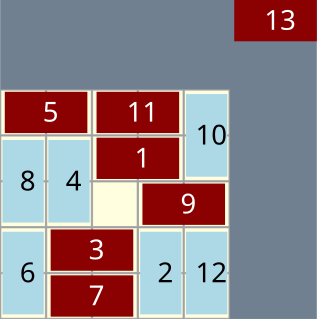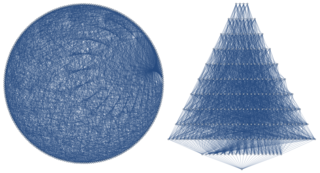
Dots and Boxes is a pencil-and-paper game for two players. It was first published in the 19th century by French mathematician Édouard Lucas, who called it la pipopipette. It has gone by many other names, including the dots and dashes, game of dots, dot to dot grid, boxes, and pigs in a pen.

John Horton Conway was an English mathematician active in the theory of finite groups, knot theory, number theory, combinatorial game theory and coding theory. He also made contributions to many branches of recreational mathematics, most notably the invention of the cellular automaton called the Game of Life.

Nim is a mathematical game of strategy in which two players take turns removing objects from distinct heaps or piles. On each turn, a player must remove at least one object, and may remove any number of objects provided they all come from the same heap or pile. Depending on the version being played, the goal of the game is either to avoid taking the last object or to take the last object.
In combinatorial game theory, an impartial game is a game in which the allowable moves depend only on the position and not on which of the two players is currently moving, and where the payoffs are symmetric. In other words, the only difference between player 1 and player 2 is that player 1 goes first. The game is played until a terminal position is reached. A terminal position is one from which no moves are possible. Then one of the players is declared the winner and the other the loser. Furthermore, impartial games are played with perfect information and no chance moves, meaning all information about the game and operations for both players are visible to both players.
Misère, misere, bettel, betl, beddl or bettler is a bid in various card games, and the player who bids misère undertakes to win no tricks or as few as possible, usually at no trump, in the round to be played. This does not allow sufficient variety to constitute a game in its own right, but it is the basis of such trick-avoidance games as Hearts, and provides an optional contract for most games involving an auction. The term or category may also be used for some card game of its own with the same aim, like Black Peter.
Winning Ways for Your Mathematical Plays by Elwyn R. Berlekamp, John H. Conway, and Richard K. Guy is a compendium of information on mathematical games. It was first published in 1982 in two volumes.

Combinatorial game theory is a branch of mathematics and theoretical computer science that typically studies sequential games with perfect information. Study has been largely confined to two-player games that have a position that the players take turns changing in defined ways or moves to achieve a defined winning condition. Combinatorial game theory has not traditionally studied games of chance or those that use imperfect or incomplete information, favoring games that offer perfect information in which the state of the game and the set of available moves is always known by both players. However, as mathematical techniques advance, the types of game that can be mathematically analyzed expands, thus the boundaries of the field are ever changing. Scholars will generally define what they mean by a "game" at the beginning of a paper, and these definitions often vary as they are specific to the game being analyzed and are not meant to represent the entire scope of the field.
In combinatorial game theory, a game is partisan if it is not impartial. That is, some moves are available to one player and not to the other.

Elwyn Ralph Berlekamp was a professor of mathematics and computer science at the University of California, Berkeley. Berlekamp was widely known for his work in computer science, coding theory and combinatorial game theory.

Domineering is a mathematical game that can be played on any collection of squares on a sheet of graph paper. For example, it can be played on a 6×6 square, a rectangle, an entirely irregular polyomino, or a combination of any number of such components. Two players have a collection of dominoes which they place on the grid in turn, covering up squares. One player places tiles vertically, while the other places them horizontally. As in most games in combinatorial game theory, the first player who cannot move loses.

Hackenbush is a two-player game invented by mathematician John Horton Conway. It may be played on any configuration of colored line segments connected to one another by their endpoints and to a "ground" line.
The combinatorial game Toads and Frogs is a partisan game invented by Richard Guy. This mathematical game was used as an introductory game in the book Winning Ways for your Mathematical Plays.
In mathematics, tiny and miny are operators that yield infinitesimal values when applied to numbers in combinatorial game theory. Given a positive number G, tiny G is equal to {0|{0|-G}} for any game G, whereas miny G is tiny G's negative, or {{G|0}|0}.
In combinatorial game theory, a branch of mathematics, a hot game is one in which each player can improve their position by making the next move.
Treblecross is a degenerate tic-tac toe variant. The game is an octal game, played on a one-dimensional board and both players play using the same piece. Each player on their turn plays a piece in an unoccupied space. The game is won if a player on their turn makes a line of three pieces in a row.
David Wolfe is a mathematician and amateur Go player.
In combinatorial game theory, cooling, heating, and overheating are operations on hot games to make them more amenable to the traditional methods of the theory, which was originally devised for cold games in which the winner is the last player to have a legal move. Overheating was generalised by Elwyn Berlekamp for the analysis of Blockbusting. Chilling and warming are variants used in the analysis of the endgame of Go.

In graph theory, the Berlekamp–Van Lint–Seidel graph is a locally linear strongly regular graph with parameters . This means that it has 243 vertices, 22 edges per vertex, exactly one shared neighbor per pair of adjacent vertices, and exactly two shared neighbors per pair of non-adjacent vertices. It was constructed by Elwyn Berlekamp, J. H. van Lint, and Johan Jacob Seidel as the coset graph of the ternary Golay code.
In graph theory, the Games graph is the largest known locally linear strongly regular graph. Its parameters as a strongly regular graph are (729,112,1,20). This means that it has 729 vertices, and 40824 edges. Each edge is in a unique triangle and each non-adjacent pair of vertices have exactly 20 shared neighbors. It is named after Richard A. Games, who suggested its construction in an unpublished communication and wrote about related constructions.
The Berlekamp switching game is a mathematical game proposed by American mathematician Elwyn Berlekamp. It has also been called the Gale–Berlekamp switching game, after David Gale, who discovered the same game independently, or the unbalancing lights game. It involves a system of lightbulbs controlled by two banks of switches, with one game player trying to turn many lightbulbs on and the other trying to keep as many as possible off. It can be used to demonstrate the concept of covering radius in coding theory.








